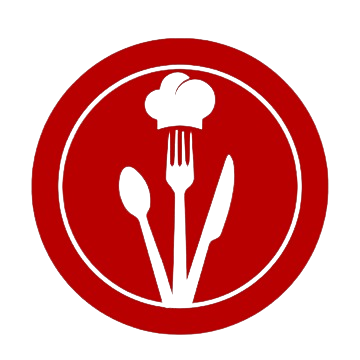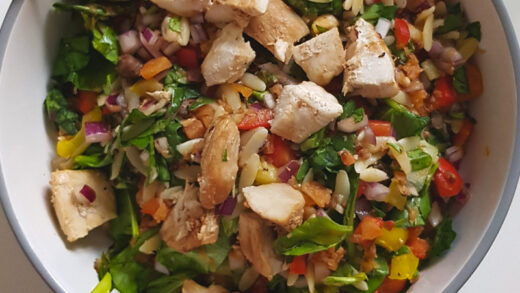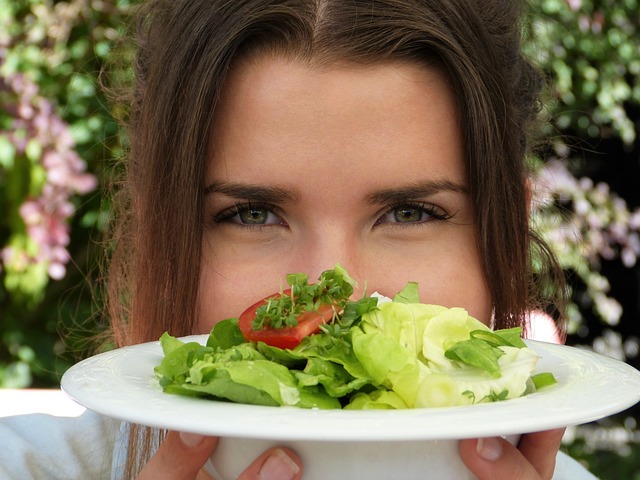
If you’re growing your apple trees organically, it’s important to protect them from pests and diseases and if you know when to spray your fruit trees, that job will be much easier for you. There are a number of different approaches. In this article we cover using certified organic fruit tree sprays. In another article we explore homemade fruit tree sprays that effectively boost fruit tree immunity.
But let’s start with certified organic fruit tree sprays. In episode 52 of The Urban Forestry Radio Show and Podcast, show host and fruit tree care educator Susan Poizner speaks to Trumansburg, NY based orchard consultant Mike Biltonen about organic fruit tree sprays that you can use throughout the year.
Here is what we cover in the interview below:
- When to spray apple trees and why timing matters
- How to research which sprays to use
- Dormant season apple tree sprays
- Blossom time apple tree sprays
- Summer season apple tree sprays
- Where to learn more
The interview text is edited for clarity. Watch the short video below for an overview, and/or scroll down to learn more!
when to spray apple trees
Timing matters when it comes to spraying apple trees. If you get the timing right, you can prevent many apple tree pest and disease problems. If you get it wrong, you can kill beneficial insects and damage your trees. So in the questions below, we explore what sprays do and why timing is important.
QUESTION: How can sprays help prevent apple tree pests and diseases?
MB: There are quite a few insect pests and diseases that vary throughout the growing season. Depending on what part of the world that you’re in, pests and diseases can begin in late March or early April and can last until October and November. Being able to understand what these insects and diseases are, and knowing how to help your trees withstand the onslaught, is important. Doing nothing is not an option. But a spray schedule doesn’t have to be super intensive. As long as we’re choosing the right sprays for the right time of the, it really can help grow a healthy tree and healthy fruit.
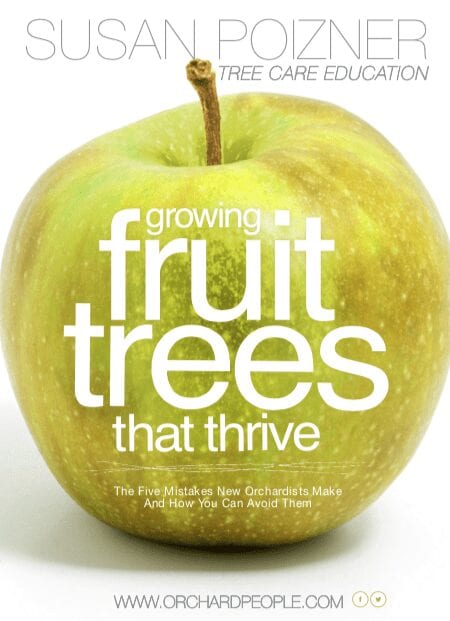
Fruit Tree Care Newsletter
Sign up for our monthly newsletter and we will send you our eBook “Growing Fruit Trees That Thrive.” You can unsubscribe at any time.
QUESTION: What happens if you don’t use sprays on apple trees?
MB: Apple trees, for instance, can get a number of diseases like apple scab, cedar apple rust, and there’s a new one that we’re dealing with called Marssonina leaf blotch. If these diseases get severe, they can defoliate the tree. If the tree defoliates, then it can’t photosynthesize. And if it can’t photosynthesize, then it can’t create the sugars and the nutrients and the compounds that it needs to stay healthy as a tree or to grow good fruit.
On the insect side, there are insects that cannot just damage the tree, but can actually kill it. There are borers of different types that will bore into the trunk of the tree. Borers can girdle the tree and eventually cause the tree to decline. It could happen quickly, but usually it happens over the course of a few years to where the trees can just decline and die.
QUESTION: How do you research what fruit tree sprays to use?
MB: Not every region has the same problems. In New York, for example, the issues that we have in the primary fruit growing region along Lake Ontario are different from the issues on the Ontario Peninsula. So, understanding what your pressures are from the insect and diseases is very important.
Once you’ve got a handle on those basics, understanding the ebb and flow through the growing season is important. You need to know when certain diseases or insects are problematic and when they’re not. That can change dramatically throughout the growing season. Sometimes, very little intervention is needed. At other times it can be fairly intensive.

When to spray apple trees – Dormant Season
So let’s start with the dormant season. At this time of year, there are things you can do to ensure that your trees will be less attractive to pests in the growing season to come.
QUESTION: When does the dormant season begin and end?
MB: The dormant season technically begins at the end of a current growing season when the fruit has been harvested and the leaves fully defoliated. At this point, all of the tree’s carbohydrate reserves have gone into the roots and the trunk and the branches of that tree.
Fruit trees need to achieve a certain number of chilling units or cold days before they can start to grow again. The dormant season can extend from the middle of November, all the way up until the middle of March. And then in the middle of March, it starts to accumulate growing degree days (GDD) during warm days.
At that point we won’t see the trees start to grow and they will still look dormant. But in the spring, trees are slowly starting to wake up. And just like with maple trees, the sap starts to rise before the leaves come out. That sap is carbohydrates starting to rise again.
We see the end of the dormant season when the bud scales and the overwintering fruit buds start to expand slightly, and we can see a change in color in the bark and in the buds. That’s really when we can say, okay, it’s game on. The growing season has started.
The timing for the end of dormancy can vary from year to year. I’ve seen it in New York where we’ve had the dormant season appear to end in early March only to have more winter set in. And other years it can stay relatively cool through March and the trees may not look like they’re waking up until early to the middle of April.
QUESTION: What are the pest and disease pressures in the dormant season?
MB: Well, just like the trees are sleeping and recovering during the winter, a lot of insects and diseases are going through a dormant period of their own and many of them do their winter rest on the tree itself. Some examples might be mites, scales, or wooly apple aphids.
Some diseases, particularly bacterial diseases like fireblight, will be residing on the tree itself. In order to reduce the pest pressure or the disease inoculum when the season starts, there are some treatments that we can apply that will help to reduce the population say of overwintering mite eggs or overwintering scale. And by getting a jump on the season, it reduces the potential for those pests and diseases to be bigger problems in season than they would be if we didn’t do anything.
QUESTION: What apple tree sprays might we use during the dormant season?
MB: One of the most classic options is just a horticultural oil. And the horticultural oil would be applied in a dilute spray. And by dilute, I mean maybe 1% to 2% oil in water, and that would be applied to the entire surface of the tree. What the oil does is it smothers the mite eggs or the scale or the wooly apple aphids.
You can use some other sprays, copper being one of them, lime sulfur would be another, and also neem oil and Karanja oil which are seed oils from trees in India have also become very popular. They act differently than horticultural petroleum oils and they actually have some added benefits for the health of the tree, but in the dormant season, those are the basic options that we’re dealing with to help with these overwintering insects and disease pressures.

Fruit Tree Care Newsletter
Sign up for our monthly newsletter and we will send you our eBook “Growing Fruit Trees That Thrive.” You can unsubscribe at any time.
QUESTION: When would you need to use copper spray on apple trees?
MB: Well, so copper is very good against bacterial diseases like fire blight or bacterial canker. It’s also a good fungal protector, but it’s much better as a bacterial treatment. Lime sulfur is much better as a fungal treatment. So, if you have a history of fireblight in your orchard or if you’ve had a history of fungal infections in your orchard, you may opt for one of the other as a prophylactic. You certainly could apply both and at the appropriate rate. You could cover all bases.
QUESTION: What is fire blight?
MB: Fire blight is a bacterial disease. It’s of worldwide significance in pome fruit, which is primarily apples and pears, but it also can infect hawthorn and raspberries and other plants in the Rosaceae family. The scientific term is Erwinia amylovora. It was originally identified first and we think that it actually started in the Hudson Valley of New York. So that’s our little gift to the planet.
And fireblight is a bacterial disease that actually moves systemically in the vascular system of the plant. The most important point of entry is through the blossoms in the spring, but you can also get infections through leaves or branches say after a hailstorm or a heavy windstorm. So it can enter through any type of opening in the tree itself, but again, the most important entry point is in the spring time during bloom when it can enter through the flowers.
And then once fire blight starts to spread systemically, it not only could kill the flower, but it can kill the spur, which is what the fruit bud is born on. It can infect the branch, and in very severe cases, it can actually kill the tree. And there’s some varieties which are much more susceptible to fire blight than others, and there are some apple rootstocks which are much more susceptible to fire blight than others.
QUESTION: What is neem oil? When would you spray apple trees with neem oil?
MB: Neem is a very interesting material to use. Pure neem oil originates from the neem tree in India, and in its unadulterated shape it has the consistency of peanut butter and it doesn’t begin to liquefy until it gets up above 60 degrees or so.
What’s happened is that manufacturers of horticultural products have started to strip out some of the constituents that create this very viscous texture at low temperatures. And what’s left are products that are not referred to as neem, but as Azadirachtin. There are a number of different Azadirachtin products that are out on the market.
QUESTION: What are the benefits of neem oil when spraying apple trees?
MB: Neem oil brings a number of properties with it. Of course you get the oil. So like a horticultural petroleum oil, you’re going to get the smothering effect on mite eggs and scale and the like.
You also get a number of constituents, fatty acids being one of them, that are really important for feeding the microbiome (beneficial microbe population) that’s on the surface of that tree. Neem also helps to debilitate and slow the development of overwintering insects that are on the tree.
Editor’s Note: Learn how to integrate neem oil into a home-made holistic fruit tree spray
QUESTION: When is the best time to spray apple trees during the dormant season?
MB: When it comes to oils or copper and lime sulfur, if those products are applied when there’s foliage on the tree, you can get phytotoxicity (damaged or burning of the leaves). And if it’s even later than that, you could potentially get burning of flowers or roughening of the fruit.
And so, if you know that you have a mite problem or a scale problem, you need to apply those materials earlier in the dormant season. Maybe in mid-March, mid to late March or so. At that time, you can apply them in a higher rate and have a greater impact on those pest species populations.
The sooner we get to that bud swell, bud break, and what we call green tip, which is when you start to see the very, very first hints of green tissue emerge, we need to reduce the rates so that we don’t cause any phytotoxicity problems in the tree itself.
By reducing the rates once the buds start to break, we’re obviously going to have less efficacy against some of those insects and disease pests. But as well, those pests are starting to wake up and they become more susceptible. So, there’s a little bit of a sweet spot.
I don’t like to recommend applying anything too early in the dormant season. I also don’t want to apply it too late because then we have to reduce the rates too much. So somewhere right around what we call delayed dormant. So just as the buds start to swell, but before there’s that green tissue, that’s really the sweet spot of when you want to apply these for the most efficacy.
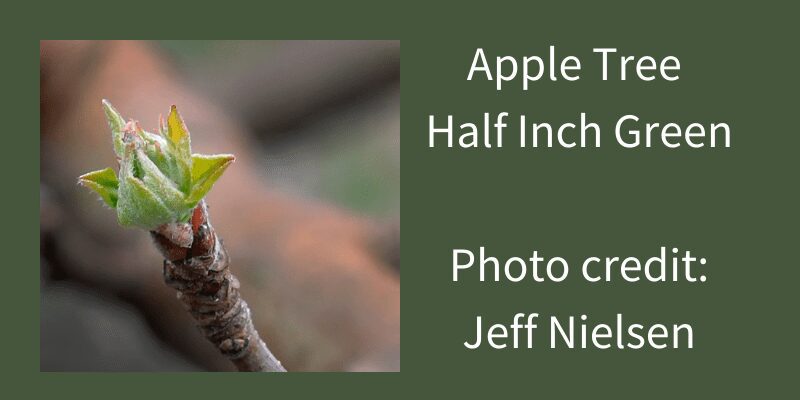
when to spray apple trees: blossom time
So, as we have seen above, there are many spray options that can be used during the dormant season, especially in the early spring. But once the buds break and the blossoms open up, there are fewer options. One of the biggest concerns is that if you spray during blossom time, you can harm (or kill) pollinators and beneficial insects. So let’s explore which sprays can be used during blossom time next.
QUESTION: What is happening in the tree at blossom time?
MB: When it comes to apple trees, the flowers that see in the spring were developed last June and July. When the tree starts to grow in the spring, that tissue will begin to differentiate into the various flower parts.
For your average backyard gardener, you’re really not going to start to see the beginnings of the flower until what we call “half inch green”, which is a phenological stage. And at that stage, you can start to see the flower really begin to swell up. And it looks different from vegetative buds, which don’t have any flowers attached to them simply because it’s just bigger and plumper.

And the next stage after that is going to be a stage that we call “tight cluster”. And at that point, the leaves have started to unfold and the flower parts have pushed open. Now, it’s still not a viable flower. It can’t be pollinated.
Depending on the weather, it will be in a week to two weeks when we start to get the first open blossoms. And that’s when the petals and the sepals of the flowers start to open up and you can see the pistils and the anthers, which are the fruit-bearing and pollen parts of the flower. When you start to see the flowers open it’s called “bloom time.”

So, bloom time is when this first blossom start to open. The petals are open. The flower can be pollinated. Fertilization can take place. Fruit development can begin. And then full bloom is when 90% of the flowers are open. And then bloom time ends.
Bloom time will depend on the weather. So, if it’s really hot and dry and windy, it could be over in a matter of days. Or if it’s relatively cool and the weather is very nice, that bloom period can last anywhere from two and even up to three weeks long.
Once it’s over, the flower will shed those petals. And that period, that phenological stage is what we call “petal fall”. At that point, we can really start to see the receptacle in the flower begin to expand and we can see the very first beginnings of fruit development.
QUESTION: When can you spray apple trees during bloom time?
MB: It‘s best if you can avoid spraying anything during bloom time because the flowers are delicate. If you spray the wrong thing – or spray the right thing at the wrong time – you can damage those flowers and really have a serious impact on your ability to grow a crop of apples.
Now, that said, there are a number of insects and diseases that need to be considered and that growers need to be aware of because they can be particularly nasty during the bloom period, fire blight being one of them. At bloom time the tree is at its peak susceptibility for fire blight.
And insect pests. Probably the most nefarious is the European apple sawfly, which can infest the flower. If the female lays her egg at the base of the flower below the petals, you get this larval development which kills it.
So, if you can avoid spraying things, that’s best, but you also need to be aware that there are things that can impact your apple crop and you may need to spray either right before full bloom or in the case of fire blight, sometimes you need to spray during full bloom.

QUESTION: What sprays would prevent the spread of fire blight in apple trees?
MB: There are a number of options. Now, we talked about spraying copper during dormancy. There are copper sprays that you can apply during bloom, but they’re not the same copper formulation that you would use during the dormant season. So they’re going to be safer to use against the flowers. And the copper helps to reduce the bacteria that are on the surface of the flower and can reduce the potential for infection. Bonide makes a copper spray which is a copper octanoate, a 10% solution. And if you used according to the label, it can successfully reduce your chances for getting fireblight.
Another product that I like to use is Double Nickel. There are a variety of off-the-shelf products, but Double Nickel itself is a combination of two bacillus organisms, bacillus subtilis, otherwise known as Serenade, and bacillus amyloliquefaciens, which is known by a number of different trade names.
Even though it’s considered to be a fungicide, those two bacillus species are bacterial suppressants. So they may not kill the bacteria outright in the way that copper will, but they’ll reduce the ability of that bacteria to grow and be successful on the surface of the plant.
And so if you’ve got a potential for fire blight infection, you can apply a light rate of copper and a light rate of these bacillus organisms to help reduce the Erwinia bacteria that’s on the surface of the plant.
There are also some other more biologically driven options that are out there. One is called Blossom Protect, and these are yeasts and beneficial fungi. They’ll grow just like any other type of microorganism well but they’re beneficial in that they can act as bacterial suppressants. They can also out-compete territorially on the surface of the plant so that the Erwinia just doesn’t have a chance to ever grow to any dangerous level.

when to spray apple trees: Summer Season
Once all the petals fall from your apple trees, your summer spray schedule will begin. Next Mike explores the different apple tree sprays that you will use at that time.
QUESTION: What are some summer sprays for fruit trees?
The first 10 to 12 weeks of the season, from dormant until petal fall, is when we’re seeing everything start to waken up and be present in the orchard. After petal fall and during those initial fruit growth stages is when we’re starting to see more of the summer insects and diseases that come out.
Now, they’re going to be different than the early season insects and diseases. Some will be the same, but the intensity from an organic standpoint tends to go down a little bit.
You can use granulosis for codling moths. DiPel or any bacillus thuringiensis product can be used to help control other larval organisms like oblique-banded leafroller, green fruitworms, oriental fruit moth, codling moths to some degree. And then there’s also Entrust or Spinosad insecticide which is also an important part of that overall rotation.

Fruit Tree Care Newsletter
Sign up for our monthly newsletter and we will send you our eBook “Growing Fruit Trees That Thrive.” You can unsubscribe at any time.
When those are used in conjunction with a kaolin clay product like Surround, they can provide a very robust insect control program and keep everything at fairly low levels.
When you get later into the season, and again, depending on where you are, it could be mid-July to early August, you’re going to see something come out called apple maggot fly. And those can be controlled organically using red sticky spheres and lures and just trapping them out. But Entrust or a Spinosad insecticide and Surround will also keep any potential apple maggot problems at a low level.
One final product that’s out there are the pyrethrins or pyrethroids. PyGanic is probably the most common or popular of the organic pyrethroids products that are out there. They tend not to be as powerful as Spinosad, but when used in a rotational perspective, they can also provide a lot of protection against some insect, pests, aphids, leafhoppers, that kind of stuff.
And then from a disease control standpoint, unless there’s specific issues that somebody is dealing with, again, I go back to the bacillus products plus a copper every 10 to 14 days throughout the growing season just to provide some fungal protection.
QUESTION: When would you use horticultural oil spray on apple trees during the summer season?
MB: There are some very highly refined horticultural oils. One brand’s product is called JMS Flowers. It’s a very clean horticultural oil that doesn’t have the potential for phytotoxicity, again, unless it’s misused, but it can provide some benefits for piercing-sucking insects like leafhoppers and aphids and mites. You can get some control with it during the summer. So horticultural oils or refined horticultural oil or a stylet oil as we call it can be also used in rotation with those other products.
Learn More Information about Fruit Tree Spray Schedules Here

Susan Poizner
Director, OrchardPeople.com Fruit Tree Care Education
Learn more about Susan on the about us page.
#spray #apple #trees #prevent #pests #diseases
